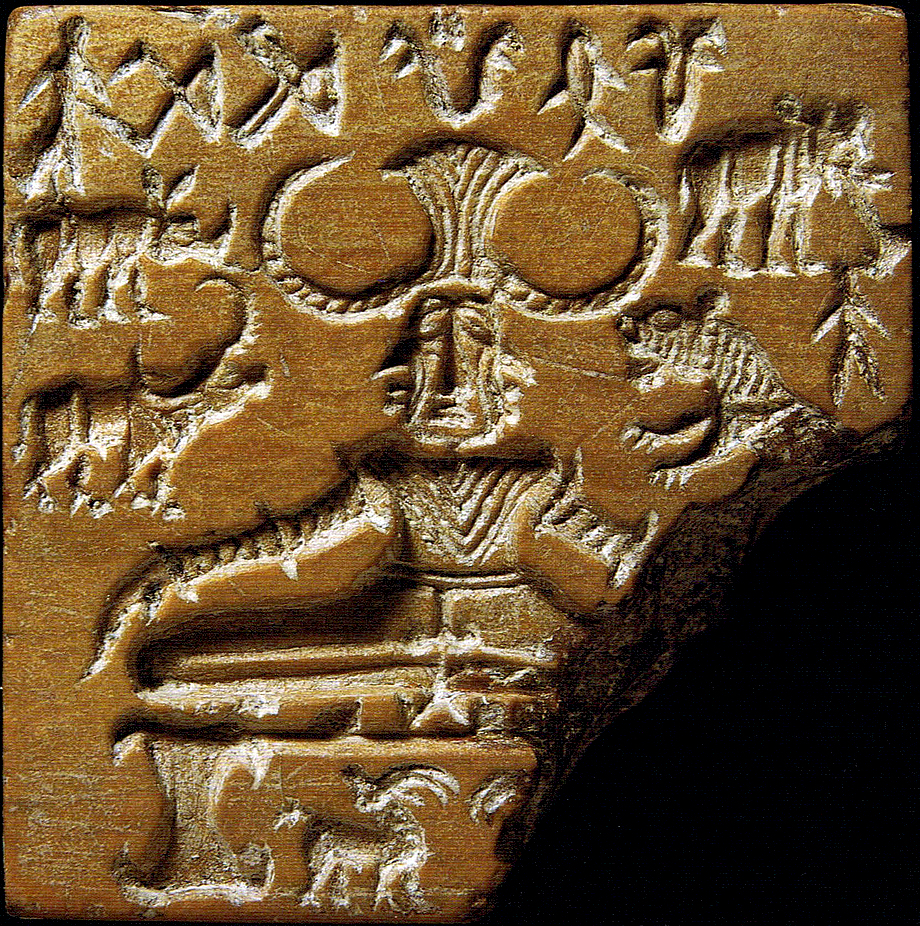
A Working Definition of Illumination Meditation
Meditation is defined as a focusing of awareness, confining the attention to a single thing, bringing the mind to a state of tranquility and clarity. There are many kinds of meditation developed all over the world for various purposes. In this article we will focus primarily on the science surrounding what may suitably be called Illumination meditation.
A good working definition of Illumination meditation includes any active or passive method of uniting the mind to its naturally whole and undivided state of being. This kind of meditation may be found in Jewish mysticism, Christian prayer and other systems, but is expressed in its purest form in a Japanese Zen Buddhist practice known as shikantaza, or “just sitting,” a derivation of Chinese Chan Buddhist meditation.[1]
Shikantaza may be described as simply sitting and being aware, holding the attention steady like a sentry, on no particular object, just observing and nothing else. Perceptions, emotions and thoughts rise and dissipate in the field of consciousness as clouds come and go within the empty sky.
This kind of alert observation is not a philosophical contemplation or necessarily a religious act. The founder of Soto Zen, Eihei Dogen (1200-1253), taught that sitting or acting with mindfulness is both practice and realization in a single act. “Buddha” means “one who is awakened,” and refers to an awakening to the reality of the observer, that attachments and aversions cloud awareness.
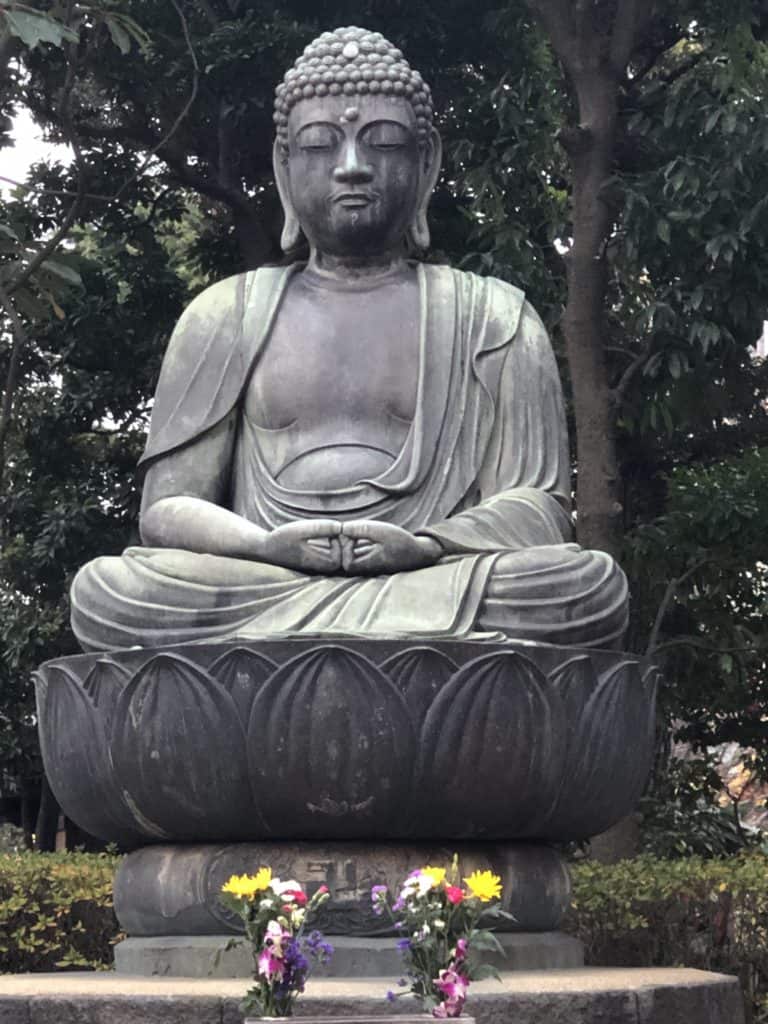
Buddhist Origins
The Buddha, who learned to meditate from his native Indian traditions, considered himself to be a teacher, not a religious leader. He directed his students not to rely even on himself, but to be skeptical, and do their own meditation experiments, research, and critical thinking.
Ultimately, the Buddha taught that there must be many ways of teaching, or expedient means, and ancient Buddhist literature relied on several oral traditions. The Buddhist religion with its diverse sects is based on the Buddha’s monastic rule and his sermons, directions intended to establish a lifestyle conducive to meditation and awakening.
The center of Buddha’s teachings was the Four Noble Truths, that life is suffering (or dissatisfaction), suffering is caused by attachment, eliminating attachment ends suffering, and this is accomplished by following certain principles, as outlined in the Noble Eightfold Path: right view, right intention, right speech, right conduct, right livelihood, right effort, right mindfulness, and right meditative consciousness.
At the core of this system is meditation and a set of vows to avoid killing, lying, stealing, intoxication and sexual promiscuity. Shikantaza, “just sitting,” exemplifies the freedom beyond attachment and suffering and leaves one in one’s natural state, as Eihei Dogen, the founder of Soto Zen described, of “ease and joy.”

Buddhist Illumination Meditation
The Buddha’s moral and ethical guidelines are simply guideposts that have been discovered for a stable lifestyle of personal well-being and an ethical social life within a community. The two main Buddhist traditions, Theravada and Mahayana, are monastic lifestyles, but each is supported by a lay community and teaches meditation such as it is said the Buddha practiced. Today, many people of various religious and nonreligious backgrounds enjoy the benefit of Buddhist or Buddhist-inspired secular meditation.
The Theravada tradition of Buddhist Vipassana “insight” meditation involves active concentrative techniques. From its origins in ancient Buddhist discipline to its scientific manifestation in Kabat-Zinn’s “mindfulness meditation,” insight meditation essentially means intentional awareness in the present moment. Many people do not know what mindfulness meditation means; studies have shown that it is often regarded as mere relaxation or religious practice.[2]
One familiar with Illumination meditation categorizes such active meditative techniques as preliminary accessories to the Mahayana Chan/Zen practice of goalless sitting known as shikantaza, or “just sitting.” That is, they are not necessary, but may be helpful to some beginners. Shikantaza, the core of Illumination meditation, is neither passive nor active.
Shikantaza is a form of zazen (Chinese zuochan), “sitting meditation,” which is regarded as an enactment ritual rather than a type of meditation. In fact, it does not matter whether one calls this kind of practice meditation or not meditation, for it is what it is no matter what one calls it.
In the language of Mandarin “meditation” is chan and in Japanese it is zen. Arising in China and later brought to Japan, Buddhist sects of these names center their practice around meditation. The Daoist-influenced wu-wei, or “non-action” of Chan’s shiguan dazuo, “Silent Illumination,” and its Japanese Soto Zen derivative, shikantaza, stands in contrast to the Theravada methods of active concentration exercises.
Yet even shikantaza, with the instruction “not thinking,” is a form of meditation, as the practitioner focuses the mind on just sitting, allowing thoughts and emotions to arise and pass naturally. This is the essence of Illumination meditation. One sits in Illumination and cultivates insight in this process of just sitting and doing nothing.

How Illumination Meditation Works
Illumination meditation in scientific terms is an action of the whole anatomy and physiology on the nervous system to affect the endocrine system and immune system. The practice acts to strengthen consciousness, relieve stress and reduce inflammation.[3] The primary effect of meditation is a change in consciousness, but other results are certainly worth mentioning, including improvements to mood, mental well-being, physical health, cognitive abilities, work performance and overall personality.
Most scientific studies of meditation focus on its physical and psychological health benefits. Science has largely ignored the utility of meditation as a tool of observation or insight. Whereas the search for the origin of consciousness continues, and studies abound in the field of altered states of consciousness, claims of enlightenment as the highest or ultimate psychological state of being go uninvestigated.[4][5]
The mystical nature of enlightenment seems religious, which prevents scientists from examining this important mystery, but the question of the authenticity of mystical claims about consciousness is verifiable by scientific method.[6]
The function of consciousness is to allow an organism to perceive and respond to its environment. How a person views and responds to their environment is vital to their experience of the world and the resulting circumstances. Meditation has been shown to have varying effects on consciousness and other actions of the brain.
Consciousness is the state of being awake (aroused), aware, and attentive. It is an elusive neural process about which there are many theories, but Harvard scientists may have located consciousness as an interaction of three parts of the brain.[7][8][9] In simplified terms, the brainstem produces basic arousal, and two areas within the cortex produce awareness. Attention is produced in the cortex, as well, fueled by a neurotransmitter called nore-pinephrine.[10][11]
Arousal involves the midbrain reticular formation and the left and right cerebral hemispheres. Awareness depends on arousal and implies an observer who can perceive sensations and the mental stimulation. One can be asleep and aware, as while dreaming, but one cannot be asleep and conscious. Attention, the ability to intentionally focus the awareness, is the final mechanism that defines the sentient being.[12][13]
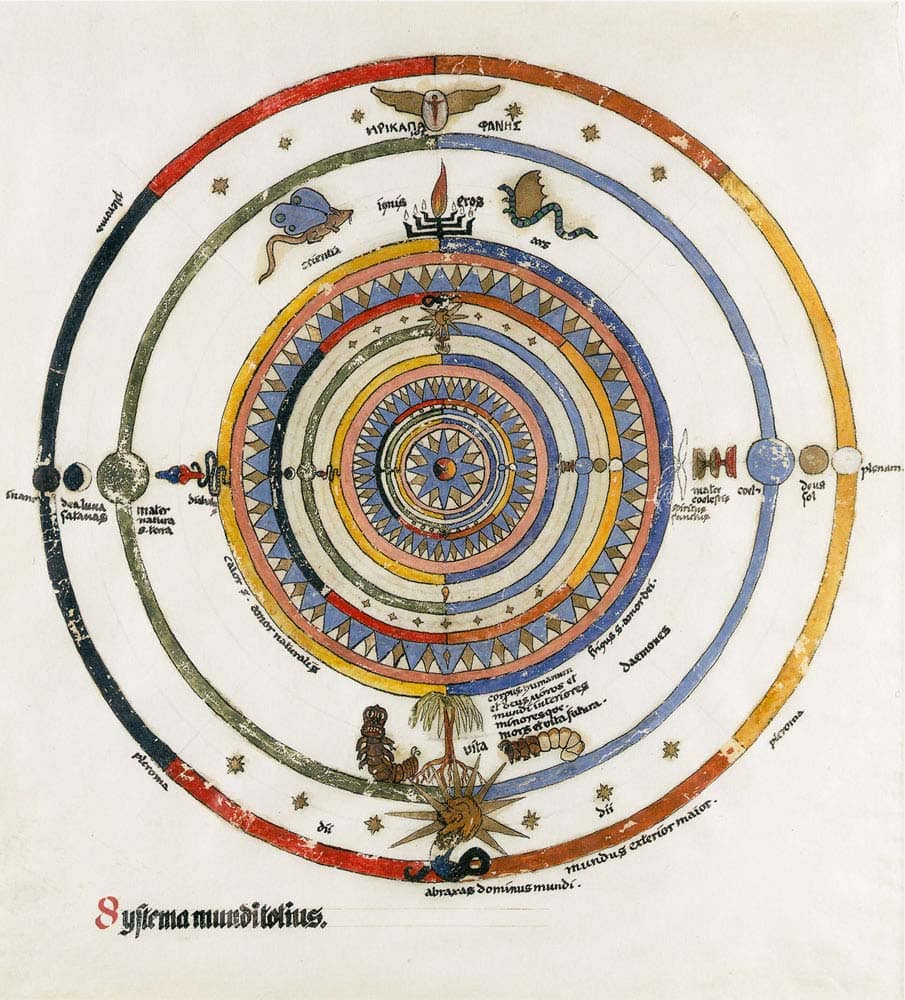
Meditation, Proto-science and Psychotherapy
Research on meditation may be said to have begun in the first half of the first millennium BCE in the East with Indian yogic mysticism, Buddhism and Chinese Daoism. A proto-scientific exploration of meditation began with ancient symbolic alchemy, a tradition that was adopted in the 1940s by the famous Dr. Carl Jung and developed into Jungian psychoanalysis, a study of the unconscious mind.
By definition alchemy is the transmutation of the base metals lead and iron into the noble metals silver and gold. The alchemist’s quest is for the pill, powder or elixir that turns every metal it touches into gold – the mysterious Philosopher’s Stone. This quest is a fitting metaphor for the science of transmuting base matter, the dross of mundane existence, into health, empowerment and enlightenment.
Where alchemy truly began is a mystery. Alchemy is a 2000 year old international tradition, spread across India, China, Egypt, the Near East and Western Europe. The origins of the alchemical tradition reach back into ancient Alexandria, Egypt in the West and Ch’in Dynasty China in the East. It is unknown whether alchemy arose independently in the Orient and the Occident or if it was passed from one half of the earth to the other.
Symbolic alchemy, known as the Royal Art, was transmitted privately, in print, and fraternally through societies like the Freemasons and the Rosicrucians. It has influenced great minds such as Paracelsus, Goethe, Mozart, Isaac Newton and C. G. Jung.
Eastern meditation was studied in European and then American occult circles as early as the eighteenth century. It was mostly unknown in the West until the mid-nineteenth century, when transcendentalists took an interest in Hindu meditation, especially as expressed in the Upanishads. The most prominent Western scientific mind to first take a look at meditation was the founder of modern American psychology, William James (1842 – 1910).
About meditation, James stated that, “The faculty of voluntarily bringing back a wandering attention, over and over again, is the very root of judgment, character, and will. No one is compos sui (master of oneself) if he have it not. An education which should improve this faculty would be the education par excellence. But it is easier to define this ideal than to give practical directions for bringing it about.”[14]
Sigmund Freud (1856 – 1939) was the founder of a form of psychotherapy called psychoanalysis, a system of psychological techniques to treat mental-health disorders based on research into the unconscious mind. Psychotherapy uses psychological research to inform methods of altering emotions, thoughts and behavior to improve a patient’s mental health, well-being and social relationships. Therapists may or may not be medical professionals, and methods therefore range from the evidence-based to the pseudo-scientific.
Psychotherapy typically sought to explain elements of the unconscious mind to arrive at a diagnosis. As evidence-based medicine has advanced, psychoanalysis has been largely replaced by the more scientific cognitive behavioral therapy (CBT), which applies specific modalities to reduce the symptoms of medically diagnosed mental disorders. Meditation is just one treatment that may be used along with other methods to help treat certain disorders, such as depression, anxiety or post-traumatic stress disorder (PTSD).
Freud wrote in Civilization and Its Discontents (1930) that meditation was a regressive experience. Franz Alexander’s paper “Buddhist Training as an Artificial Catatonia” published in 1931 reflected Freud’s Eurocentric disdain for Eastern practices. The first serious attempt to bring Eastern meditation into modern Western medicine was Carl Jung’s practice of psychotherapy, or analytical psychology.
Dr. Carl Jung, Alchemist and Psychoanalyst
Carl Gustav Jung (1875 – 1961) was a Swiss student of the founder of modern psychoanalysis, Sigmund Freud. He developed his own system of psychotherapy that rivaled Freud’s from its inception. Karl Gustav, his grandfather and “inspiration” after whom he was named, was an ardent Freemason and was Grandmaster of the Grand Lodge in Switzerland.
Jung was a student of Kabbalah, symbolic alchemy (Chinese Daoist and Western), Western and Eastern philosophy, and theology. His first studies assign mental disorders to certain experiences of occult phenomena. His research on schizophrenia led him to the theory of the collective unconscious, which proposed that a part of the human mind contained common mythological elements called ‘archetypes.’ Archetypes are expressed in myths, dreams, visions, and hallucinations.
Carl Jung recognized the tendency of the Western mind to neglect the emotional self and overwork the intellectual. He suggested that a healthy human being balanced these opposing functions. He promoted the conscious discipleship to the inner voice as the way of integration of the unconscious and conscious selves, to make for a whole person. He used the creation of mandalas, Hindu and Buddhist circular sacred artworks, to express psychic situations.
Jung understood that alchemy was the Western equivalent of Indian yogic meditation, but that it was usually kept secret in the West due to fears of religious persecution.[15] He viewed Hindu meditation, Buddhist meditation, and prayer as manifestations of the universal religious or philosophical concentration of mind.[16] Jung saw daily distractions as the cause of neurosis and meditation seeking the void as a remedy.[17] He found such a method of meditation in symbolic alchemy.
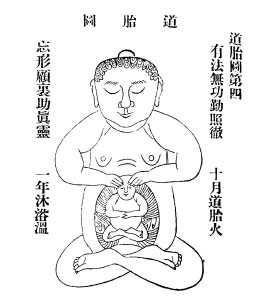
Jung’s Symbolic Alchemy
The Secret of the Golden Flower, written during the Qing Dynasty (1644 – 1912), was the book that piqued Jung’s interest in symbolic alchemy and inspired his psychoanalytical methods. The work is a Chinese Daoist technical manual of meditation teaching the techniques of sitting silently, breathing and contemplation. The text was translated to German by Richard Wilhelm in 1929 with a commentary by Carl Jung, a personal friend of Wilhelm’s.[18]
The Secret of the Golden Flower describes a golden castle, wherein rules the lord of the cosmos, the inner guide within every Homo sapiens. The Secret of the Golden Flower describes the Dao (the ineffable source of the universe) as the light and the great One with naught beyond it. The Golden Flower is a symbol of the energy of the Dao that focuses the mind between the two eyes, symbolized as the sun and moon.
Wu wei – non-action or spontaneous action – is attained through the conscious action of visualizing circulating light, which proceeds into the creation of a spiritual seed or embryo. The seed is put through operations of heating, nourishing, bathing, melting and mixing to produce the Elixir of Life, leaving the earthly world to join the heavenly realm.
Chapter Three, “Circulation of the Light and Protection of the Center,” describes specific alchemical meditation techniques beginning with meditation confessed to be a Buddhist as well as a Daoist practice.
The alchemical guide directs the alchemist to sit comfortably in an upright posture, lower the eyelids and focus the eyes on the tip of the nose and the point between the eyes in order to prepare for the circulation of the light. Once the attention is fixed between and behind the eyes, in a space referred to as the ‘middle castle,’ the light will stream in of itself, but attention does not need to be settled there. This is the secret of the Golden Flower.

Origins of the Modern Science of Meditation
After Carl Jung, researchers began studying the physiology of religious forms of meditation. Clinical studies on the same occurred only much later. Then, scientists focused rather on creating and experimenting on more secular methods of meditation based on the ancient systems of yoga and Buddhism. As might be predicted, early studies were poorly designed, and today the world is really only at the very beginning of good quality scientific exploration of meditation.
The history of the modern science of meditation began in the 1950s with the first physiological studies of meditation. In the 1940s and ‘50s, Erich Fromme and Karen Horney learned about mindfulness directly from the Japanese author and professor of Buddhist philosophy D.T. Suzuki (1870-1966), the first great advocate of Zen Buddhism in the West. Horney discussed mindfulness in 1945 as living in the moment with wholehearted concentration in her book Our Inner Conflicts: A Constructive Theory of Neurosis. Fromme published Zen Buddhism and Psychoanalysis with D.T. Suzuki and Richard de Martino in 1960.
It was in the 1970s that researchers like Herbert Benson, founder of the “Relaxation Response,” initiated the first clinical studies of meditation.[19] In 1977 the American Psychiatric Association made a statement that recommended clinical research be pursued to clarify the uses and dangers of various forms of meditation.[20] A sample of the earliest key clinical studies in the science of meditation are listed below in chronological order.
- Das N. and Gastaut H., “Variations de l’activite electrique de cerveau du Coeur et des muscles squelletiques au cours de la meditation et de l’extase yogique,” Electroencephalogr. Clin. Neurophysiol. Suppl., 1955, 6, pp. 211–219.
- Bagchi B. and Wegner M., “Electrophysiological correlates of some yogi exercises. Electroencephalogr,” Neurophysiol. Suppl., 1957, 7, pp. 132–149.
- Kasamatsu A., Okuma T., Takenaka S., Koga E., Ikada K., Sugiyama H., “The EEG of ‘Zen’ and ‘Yoga’ Practitioners,” Electro-encephaolgraphy and Clinical Neurophysiology, 1957, Suppl. #9, pp. 51-52.
- Kondo N., “Zen in Psychotherapy,” Chicago Review, 1958, 12, pp. 57-64.
- Anand B, Chinna G. and Singh B., “Some aspects of electroencephalographic studies in yogis,” Electroencephalogr. Neurophysiol., 1961, 13, pp. 452–456.
- Kasamatsu A. and Harai T., “An electroencephalographic study on Zen meditation (zazen),” Folia Psychiatr. Neurol. Jpn., 1966, 20, pp. 315–336.
- Wallace R, Benson H. and Wilson A., “A wakeful hypometabolic physiologic state,” Am. J. Physiol., 1971, 221, pp. 795–799.
- Beary J. and Benson H., “A simple psychophysiologic technique which elicits the hypometabolic changes of the relaxation response,” Psychosom. Med., 1974, 36, pp. 115–120.
- Benson H,. “Systematic hypertension and the relaxation response,” N. Engl. J. Med., 1977, 296, pp. 1152–1156.
A paper read at the 15th Annual Conference of the Association for Transpersonal Psychology, August 8, 1987 offered a good summary of early research and controversies in EEG biofeedback with meditation.[21] The paper concludes that researchers should be prepared to interpret data using both empirical and subjective “spiritual” paradigms.
Meditation has often been marketed with hyperbolic and unsubstantiated claims of its therapeutic value. Before we jump to any conclusions, either positive or negative, meditation must be subject to more stringent future scientific research. Mindfulness meditation, the most popular form of sitting meditation to recently arise in the West, is one of the most studied forms of meditation as therapy.
Mindfulness
Mindfulness meditation arose from traditional Buddhist practices and the branch of medical science called psychology. It was originally popularized through Jon Kabat-Zinn’s Mindfulness-Based Stress Reduction (MBSR) program at the University of Massachusetts Medical Center in 1979. The science of mindfulness-based cognitive therapy is based on methods of cognitive behavioral therapy used in psychotherapy, and is designed to aid sufferers of clinical depression.
The MBSR method was described in Kabat-Zinn’s book, Full Catastrophe Living: Using the Wisdom of Your Body and Mind to Face Stress, Pain, and Illness (Delta, 1991). A short introduction by Jon Kabat-Zinn is online as “Mindfulness-Based Interventions in Context: Past, Present, and Future.”
Whereas MBSR is utilized to treat chronic pain, anxiety and other disorders, Mindfulness-based Cognitive Therapy (MBCT) was developed as a cognitive behavioral therapy to treat depression.[22][23][24]
Kabat-Zinn has taught meditation to people from all walks of life, from CEOs and Olympic athletes to government staff and ecclesiastics. Mindfulness programs have been adopted by such diverse bodies as educational organizations, Fortune 500 companies and the United States Armed Forces. The mindfulness meditation program has been adopted by medical facilities throughout the United States and around the world.
Science has shown that mindfulness meditation can induce feelings of comfort and bliss, and make one more aware of oneself and the environment, as well as benefit emotional well-being and mental health in general.[25][26]
Mindfulness-based Stress Reduction (MBSR) seems to foster relaxation, improve mood by limiting judgement on negative thoughts, moderate anxiety and depression, increase control of the attention, the emotions and the physical body, and lead to desensitization of pain.[27] Recent studies have concluded that mindfulness helps alleviate stress, anxiety and depression in college students and can improve depression symptoms in older adults, including stress, pain and insomnia.[28][29]
Although scientific research shows the positive benefits of these therapies and indicates promising conclusions in future studies, not enough clinical research has been carried out to date to offer a full understanding of mindfulness. The bulk of scientific research on meditation today is woefully inadequate.
Firstly, there seems to be some general confusion as to how to distinguish or classify different types of meditation. This should not be an issue. It is not difficult to establish separate categories of meditation, such as holotropic breathwork, guided visualization, contemplation, kinesthetic meditation, mindfulness and shikantaza and samadhi (trance or concentrated higher consciousness).
Secondly, past scientific experiments on meditation have been found to produce contradictory results. There are problems with measurement due to nature vs. nurture in participants, but there is also the issue of studies having been poorly designed. The length of meditation period and the meditation experience of the participants have not always been factored into the study. The number of participants has often been too low to come to accurate conclusions. This being the case, it is prudent to be extremely careful in accepting and interpreting results in this field of inquiry.
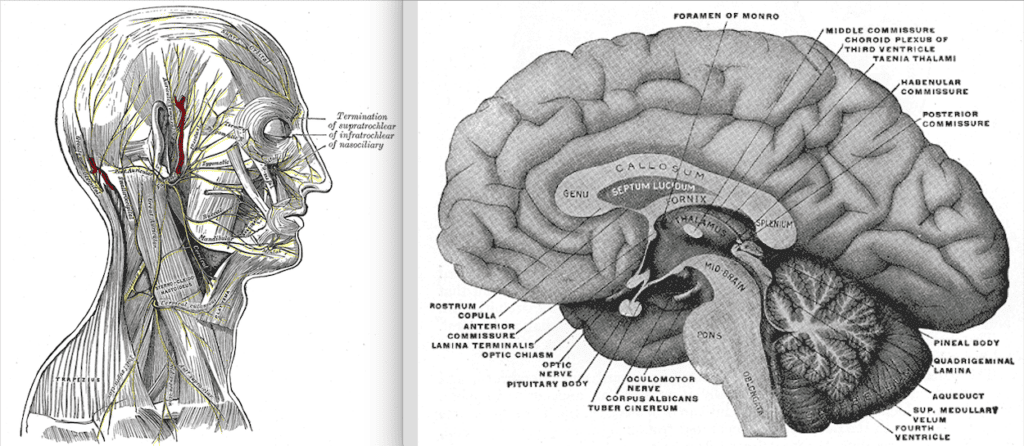
Meditation Research
Different studies on meditation have shown contradictory physiological outcomes. Research on brainwave activity is inconsistent, different experiments variously showing increased alpha, beta, delta or theta electroencephalograph (EEG) activity. Heart rate and respiration rate have been shown to decrease, remain constant or increase.
Likewise, skin conductance (electrodermal response), a measure of emotional arousal based on the application of electrodes, either increases or decreases depending on the study. Even when a study is well-designed, there is still the question of nature and nurture in experiment participants.[30]
Varying findings may be due to different meditation techniques or the subjects’ individual responses to meditation. In the mid-1980s researchers like Dr. Michael (Michelo) Delmonte found that the length of meditation time and the cumulative effects of long-term meditation are factors in responses to meditation. Beginners have different experiences than those who have practiced meditation for a longer time, and similarly, results after a short period of meditation may be different than results after a long period of meditation.
Although not conclusive, clinical studies have encouraged therapists to utilize mindfulness meditation as a modality in psychotherapy. In 1993 Marsha Linehan created dialectical behavior therapy based on Zen meditation, and in 1995 Mark Epstein’s landmark work, Thoughts Without a Thinker, opened the discussion of how Buddhist psychology could inform modern psychoanalysis. Neurologist James H. Austin’s 1998 Zen and the Brain: Toward an Understanding of Meditation and Consciousness was an early look at Zen through the lens of neuroscience.
Cognitive-behavioral research on meditation was inspired by the 2000 John D. Teasdale et al. publication on mindfulness-based cognitive therapy’s effects on major depression.[31] S.C. Hayes and colleagues pioneered new standards of empirical research on meditation for cognitive and behavioral therapies in the twentieth century.[32][33]
Christopher K. Germer lists a number of researchers working in mindfulness-oriented psychotherapy around the turn of the millennium in Mindfulness and Psychotherapy, a work edited by himself, Ronald D. Siegel and Paul R. Fulton.[34] The science includes research on practical therapy, Buddhist psychology integrated with Western psychotherapy and mindfulness-based psychotherapies. Germer’s survey shows how mindfulness has found its way into cognitive-behavioral therapy, psychodynamic psychotherapy, humanistic psychotherapy, and brain science.
Overwhelmingly, methodological flaws in past experiments have been found to be behind the contradictions in results around the effects of meditation. In 2005 the University of Alberta Evidence-based Practice Center researched the state of the science of meditation, reviewing 813 studies on six different forms of meditation:
yoga, taijiquan, Qigong, mantra, mindfulness [including Mindfulness-Based Stress Reduction (MBSR), Mindfulness-Based Cognitive Therapy (MBCT), Vipassana meditation, Zen Buddhist meditation], and “miscellaneous” [including Transcendental Meditation (TM®), Relaxation Response and Buddhist meditation].
The study was published by the United States National Center for Complementary and Integrative Health (NCCIH) in 2007 for the Agency for Healthcare Research and Quality, U.S. Department of Health and Human Services.[35] Research included information from hand searches, gray literature, reference tracking, expert counsel and 17 electronic databases of medical and psychological literature. Out of 3,000 studies within the electronic databases, about 96% excluded randomized control trials to count out the placebo effect, and are therefore considered to be of relatively poor quality.
From 1956 to 2005 research was found to have generally improved, however, it was estimated that only about 10% of 400 clinical studies could be rated as being of good quality. The report stated that, “Future research on meditation practices must be more rigorous in the design and execution of studies and in the analysis and reporting of results” (p. 6). It was clear that the scientific study of meditation was in need of a major overhaul.
Later Studies and the Future of Meditation Research
In 2013 Dr. Madhav Goyal at General Internal Medicine at Johns Hopkins University School of Medicine published a study in the Journal of the American Medical Association called, “Meditation Programs for Psychological Stress and Well-being: A Systematic Review and Meta-analysis.” This study reviewed 18,753 citations, and included 47 trials involving meditation, with a total of 3,515 participants.
An eight-week period of meditation was found to make moderate improvements with symptoms of anxiety, depression and pain. The study found little or no evidence regarding meditation’s effects on stress, mental health, mood, attention, or eating, sleeping or weight. Meditation was not found to have better results than conventional treatments like drugs, exercise or other behavioral therapies. No harmful effects to meditation were discovered.[36]
In 2014 Dr. Goyal’s team published a study for the Agency for Healthcare Research and Quality, further investigating the effects of meditation on stress-related outcomes, reviewing 17,801 citations, and including 41 trials with 2,993 participants. Their findings accorded with their previous research and they concluded that meditation programs, especially mindfulness-based, did reduce psychological stress.[37]
Two studies conducted in 2017 led by clinical psychologist Nicholas Van Dam aimed to quell misconceptions about meditation due to inadequate studies, public misunderstanding and the overzealous claims of the thriving mindfulness industry. Van Dam expressed intentions to help define mindfulness, to curb misinformation in order to reduce harm and disappointment, and to encourage improved research practices and scientific communication to the public.[38][39][40]
These dual studies accomplished a vast and comprehensive survey of scientific research into meditation. For example, simply defining mindfulness included input from Kabat-Zinn, Linehan, Hayes, Strosahl & Wilson in the 1990s; to Tang, Zeidan, Shapiro, Brown, Meyer, Lutz, Dunne & Davidson in the 2000s; to Brewer, Hölzel, Bodhi, Dreyfus, Gethin, Grabovac, Vago & Silbersweig, van Vugt & Slagter, Garland, Farb, Goldin, & Fredrickson, Davidson & Kaszniak, and Lutz, Jha, Dunne, & Saron in the last decade.
This research concluded that future studies require carefully defined types of meditation. Experiment results will need to be further vetted by replication and peer review. Clinical research needs to be better designed and, with neuroscience, more responsible with its claims of application in a clinical setting, while those in clinical practice should be careful in their use of mindfulness-based interventions. Finally, there needs to be more investigation into possible adverse effects of meditation, and more research is needed to develop accurate models of human well-being.
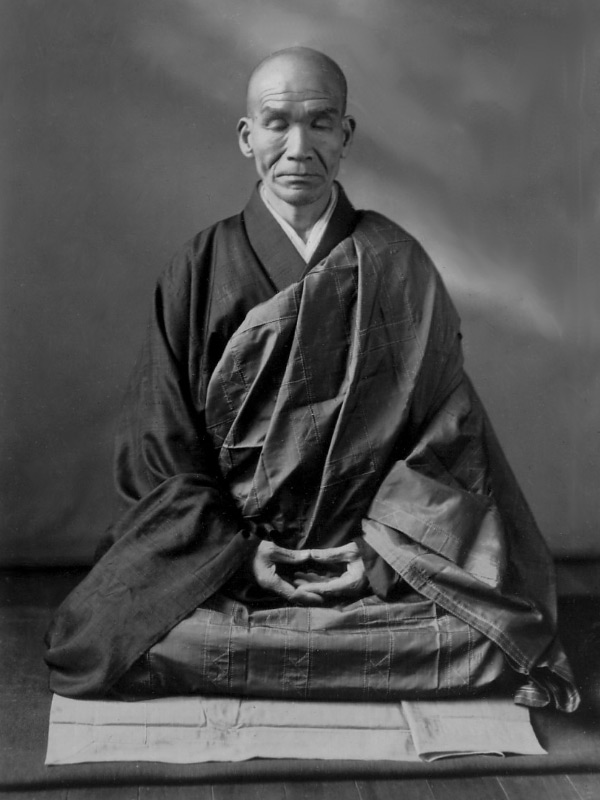
Three Scientific Categories of Meditation
Scientists have developed three categories of meditation: focused attention (FA), open monitoring (OM) and automatic self-transcending. These scientists used electroencephalography (EEG), the monitoring and measuring the electrical activity of the brain via electrodes attached to the scalp, to distinguish these three varieties of meditation by the neural oscillations, or “brain-waves,” produced by each.[41]
Open monitoring (OM) meditation requires the subject to hold the attention on monitoring, or lucid observation. OM produces theta brain waves, which are very slow, marked by dreaming, imagery or unconscious activity, found in sleep or deep meditative states.
Automatic self-transcending techniques cause the subject to mentality transcend mental and physical activity. This form of meditation produces alpha waves, the resting state of the brain, which is characterized by calmness, lucid awareness, the quieting of thoughts and emotions, integration of the body and mind, and learning.
Focused attention (FA) requires the subject to maintain concentration on an object, and was shown to produce beta and gamma activity. Beta waves are common in an alert state when focused on a mental or physical activity. Gamma waves have the fastest frequency and have been identified as related to altruism, virtue and expanded consciousness, or spirituality.
This data shows that different forms of meditation produce different results. Future experiments must be carefully designed with clear definitions regarding meditation techniques. Certain modalities, like Illumination meditation, engage all three categories of meditation.
The Benefits of Meditation
Each of the three classifications of meditation causes a number of changes to the brain, both short-term and long-term.[42] General benefits of meditation can include increased physical discipline, tolerance for discomfort, mood regulation, relaxation, concentration, and emotional intelligence.[43] Meditation can decrease chronic pain, inflammation, anxiety, depression and stress. It can boost immunity, help you pay attention, increase your gray matter, improve memory and creativity, and even have a positive impact on your social life.[44][45]
Learn more about the benefits of meditation HERE in “Power of the Mind 1: The Science of Visualization.”
Studies on meditation and yoga include information from Positron Emission Tomography (PET), Magnetic Resonance Imaging (MRI) and Single Photon Emission Computerized Tomography (SPECT) and electromyography. The research highlights the many benefits meditation bestows upon the brain.[46][47][48]
Meditation increases frontal lobe activity such as attention, inhibition, judgment, planning, and voluntary movement. Alternatively, meditation also may induce transient hypofrontality, a term that means the prefrontal cortex takes a rest and allows for a more holistic consciousness, like the runner’s high.[49]
Meditation has been linked to long-term changes in the brain, like thickening of the prefrontal cortex resulting in increased neuroplasticity, as well as slowing of age-related brain atrophy and cognitive decline.[50][51]
Studies on meditation have shown that the ability to pay attention is a trainable skill.[52] It should be reiterated here that the science surrounding meditation is in its infancy and there is a great opportunity to produce well-designed research that might give new insight into this enigmatic practice.
One study using functional MRI (fMRI: measuring brain activity as described by blood flow) and emotional sound stimuli suggests that meditation changes brain functioning over the course of time.[53] Experienced expert meditators with around 19,000 hours of practice had less activation than novices in regions of thoughts and emotions, but greater activation than novices in areas of response inhibition and attention.
However, expert meditators with around 44,000 hours of practice had less activation than novices and less experienced expert meditators in all of these regions. These findings imply that expert long-term meditators develop the ability to hold a sustained focus of attention with minimal effort.
Certain kinds of long-term meditation have also been shown to increase compassion and kindness. Such meditation could be a tool for various people, such as those suffering from depression and those who put themselves and others in danger with aggression and violence.[54]
In one study using fMRI, researchers found that meditation had a positive effect on the insula, part of the cerebral cortex, which helps process bodily sensations into emotions that influence decision-making. Meditation also increased activity in the temporoparietal junction (TPJ), which plays a major role in the theory of mind, the ability to perceive the intentions, thoughts and emotions of oneself and others. The TPJ is central to the functioning of empathy and morality.[55][56]
Meditation is not normally attempted with the expectation of ecstatic joy, but one study has shown that this can be the result of the Buddhist meditation known as jhana, which may be summed up as mindfulness of the breath. A meditator can self-stimulate the brain’s reward system to experience extreme joy.
Neuroscience has discovered using MRI and fEEG that activation of cortical processes and the dopamine/opioid reward system are put under volitional control by jhana and similar meditations.[57] Research on mindfulness is a relevant part of what might be termed “the science of happiness.”

Origins of the Science of Happiness
The science of happiness was foreshadowed in 20th century humanistic psychology with concepts like Abraham Maslow’s self-actualization and Carl Rogers’ full functioning. It was only at the turn of the century that the empirical studies of “positive psychology,” the study of the good life, have given the research into happiness a more solid foundation.
American Psychologist and President of the American Psychological Association, Martin Seligman, discovered that helplessness and happiness were learned concepts, and that subjects were happiest when engaged in goal-oriented behavior or acts of kindness.
Hungarian-American psychologist Mihalyi Csikzentmihalyi found that the happiest state is a state of concentration or absorption he called Flow. His descriptions of Flow, what he characterized as “intrinsic motivation,” are the same as traditional descriptions of dhyana (meditation) and samadhi (absorption), including a dropping of the ego and unconcern with satisfying temporal needs, while focused on a single task.
Edward F. Deiner, “Dr. Happiness,” has led research in subjective well-being, that is, well-being as measured by an individual’s own estimation, has shown that economic and health disadvantages do not determine happiness levels. Complementing inner peace that comes from within, the greatest external factors affecting happiness seem to be relationships and time with family and friends.[58] Higher levels of happiness increase health, self-control, productivity, income, and a positive social life.[59][60]
The Harvard Study of Adult Development studied the self-reported happiness of 724 men beginning in 1938, when they were in their teen years, and designed to follow the subjects into old age. The study compared a random selection of Harvard sophomore students with a random selection of young men from disadvantaged backgrounds taken from low income neighborhoods of Boston.
About seventy-five years later the results were in. People with better relationships with family, friends and community are happier, healthier and live longer than those with poor relationships. Loneliness is destructive of health, happiness and longevity.[61] Our happiness depends not just on our own inner peace, but on our relationships with others, as well as other socio-economic factors.
Many believe instinctively that wealth determines happiness. The Scottish-American economist Angus Deaton and psychologist Daniel Kahneman co-authored a study in 2010 that analyzed 450,000 survey responses, finding that self-reported emotional well-being increased with higher income up to $75,000 per year.
After this rather middle-class limit, emotional well-being, or happiness, did not significantly improve with higher wealth. However, general life satisfaction did increase with higher income, without limit. Low income was a source of life dissatisfaction and unhappiness.[62][63]
If one is seeking happiness, one should know that there are three main factors affecting happiness levels. Science indicates that one’s base happiness level may be genetic. Every individual has a happiness point, that is, a natural happiness level an individual has within, which is located in the prefrontal cortex, the cerebral cortex that covers the frontal lobe of the brain.[64][65] Ignoring material things is not recommended; it turns out that a lot of what makes one happy is the outward conditions in one’s life, not just one’s inward mood.[66]
Studying and Reporting on Happiness
The sciences of happiness and well-being are very young at this time, but slow progress in these two closely related fields are being made by psychologists and others. The Washington D.C. based Pew Research Center is an example of a respected think tank that includes among its surveys questions on happiness in the United States, which was founded on the core principles of its Declaration of Independence, “life, liberty and the pursuit of happiness.”
Some interesting Pew findings include that statistically, married people are subjectively happier than unmarried, people who worship frequently rate higher happiness than others, happiness ratings increase as wealth increases, and those who live in a warmer climate (the sun belt) are happier than those who live elsewhere. Things that surprisingly do not affect happiness ratings include owning pets, having children, and retiring from work.[67]
The Pursuit of Happiness Project
is a non-profit that studies happiness and shares its information free of charge. This organization analyzes research from diverse sciences such as neuroscience and social science. It collects data on various things that promote happiness, everything from exercise to psychobiotics, to contact with nature, to random acts of kindness.
The Happiness Research Institute
studies happiness, well-being and quality of life on an international level, focusing on behavior and public policy. The Global Happiness Council, a network of top academic specialists and other experts, publishes the Global Happiness Policy Report annually for the benefit of interested national governments.
The United Nations publishes an annual report on the state of happiness in the world. The 2018 edition of the United Nations’ World Happiness Report indicates that a country’s happiness is negatively correlated with its religiosity.[68] The most religious nations, those in the Middle East and Africa, tend to be the unhappiest, whereas the most irreligious nations, those Northern Europe, Australia and Canada, tend to be the happiest. Correlation does not equal causation, so it cannot be assumed that religion underlies causes of unhappiness, but it may play a role.
In fact, aspects of religion may even have a negative impact on community economics, health and happiness. Unsurprisingly, this is not a thriving area of research, but it might be hypothesized that any religious, political or social ideology that perpetuates misinformation and prejudice is detrimental to the happiness of people affected by the indoctrinated community. What can be said is that religion persists among poorer nations while it generally decreases as a society advances economically and socially.
The World Happiness Report study shows that happiness is correlated with higher income and economic security, better health and higher life expectancy, social supports, and civil freedoms. Happiness, therefore, is reliant not upon religion, but on material and social well-being, i.e., quality of life.[69] The science of happiness must apply to both individual and collective levels, but even then, the conditions of nature may dictate that happiness be unachievable for a certain percentage of the population.
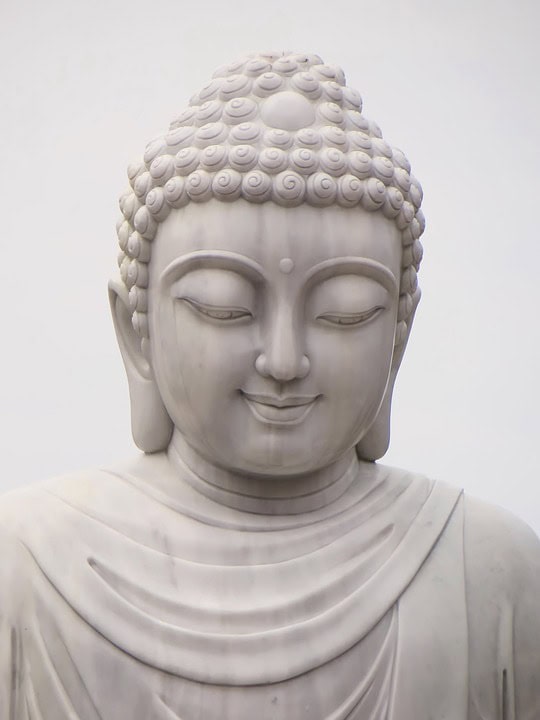
Happiness and Meditation
Science has shown that meditation improves physical and mental health, and one of its most important benefits is that it can even increase happiness.[70] Studies have shown that this is due to its action on the brain, as opposed to any cause inherent in religion. Although some may be tempted to cite religion as the cause of happiness in meditators, it has been found that the cause of happiness is not inherent in religion.
Sometimes religion does produce happiness because of tradition and social contact. Jochen Gebauer of Humboldt University in Berlin led a study, published Jan. 5, 2012 in the journal Psychological Science, which analyzed a survey of almost 200,000 Europeans. The research found that in more religious countries, religious people had higher self-esteem and more happiness than the irreligious, while in more secular countries, the religious and irreligious were equally well-adjusted.[71]
The science of happiness certainly includes incidentals, such as answers to questions like, “Where should I live?” “Where should I get an education?” “Should I get married?” “Should I have children?” “Where and how much should I work?” It must look into climate, religion, morality, ethics, politics, economics, health, and indeed every single factor that makes up our individual and collective lives.
External factors like climate, wealth and social relationships are statistically very important in self-ratings of happiness. However, meditation holds a special place in the science of happiness, for true happiness arises only when one has overcome emotional dependence on these external factors.
Happiness depends on inner peace, which transcends day-to-day struggles, even as we face reality wholeheartedly and do our best to manage our affairs. Goalless meditation is the key that allows us this state of illumination, regardless of our health, economic status, social situations, religion, and all else.
The question must be posed, if meditation has only a moderate impact on happiness, then what exactly is the point of it? Many will claim that meditation is a vital part of health. Studies show that, again, meditation has only a moderate effect on health. Health and happiness are only peripheral to the point of meditation.
Zen masters describe Illumination Meditation as “shikantaza,” or “nothing but just sitting,” without any result in mind. It must be understood why this goalless meditation is practiced when, from its origins in ancient India and China, meditation has often had one ultimate purpose: enlightenment, or illumination.
Immanence and Enlightenment
As for the Way, the Way that can be spoken of is not the constant, eternal Way.
As for names, the name that can be named is not a constant, eternal name.
The nameless is at the beginning of all things in the universe and on the earth.
– Laozi
In the Hebrew Torah, the words of Moses describe God’s creation of heaven and earth from void, “Darkness over the surface of the deep” with the ruach, translated as “wind,” “spirit,” or “breath” of God “Sweeping over the water.” The Christian term for ruach is Holy Ghost or Holy Spirit, the English “spirit” deriving from spiritus, the Latin for “breath.” The spirit is the conjectured active spark of life within all living things.
With its origins in this religious meaning, the concepts of the spiritual and spirituality have come to encompass religious and non-religious ideas associated with finding meaning in life, wholeness, connection with the universe, wisdom and well-being. The two complementary approaches to spirituality are the immanent and the transcendental.
Immanence refers to mindfulness of the here and now; the inherent meaning within mundane day-to-day existence. Transcendence is the enlightenment experience; freedom from mental suffering when the human (the subjective and relative) experiences an identification with the whole of reality (the objective and absolute), in what is known as drawing into mystical union.
Both approaches occur either accidentally or intentionally in various circumstances, especially meditation, as recorded by Chan/Zen Buddhist monks for over a thousand years. Immanence and transcendence may occur simultaneously, as during a kensho (also satori or enlightenment) experience during shikantaza (“just sitting”), the zazen, or sitting meditation, of Soto Zen Buddhism. There is debate over whether this is the ideal state of consciousness, or just another mental construct to observe and let go, and perhaps both sides are right. Modern science has examined both of these approaches to heightened awareness only to a small extent.
According to scientific studies, a vision of the universe as a oneness is, in itself, valuable to society.[72] Perhaps it makes sense to promote the health benefits of meditation, in order to get people to try it, because the concepts of immanence and enlightenment can certainly seem vague and enigmatic. There are many methods to experience the present moment wholeheartedly, or experience a transcendental identification with the absolute, of more or less efficacy and popularity, to test by experiment.
Immanence and transcendence lead to insights accepted by Buddhist and Western psychology, such as empirical causation, the impermanence of physical and mental events, the interconnectedness of all things, and the illusory nature of the sense of self.[73]
However, a discipline that might allow one to see past the illusions of the human mind into the ultimate reality of the universe is not an easy sale to the general public or to scientists and critical thinkers. Although willing to examine the evidence, the healthy skeptical mind at first doubts the very existence and the practical value of union with the Eternal, and may even be biased against claims that may seem suspiciously similar to so much pseudoscience.

Interpreting Enlightenment
Most of the science on meditation is researching its health effects such as reduction of pain, anxiety and depression. Traditionally, sitting meditation has been undertaken as a method of achieving calm and insight, and it is only recently that its utility as a health modality has become anything other than a secondary concern. Its impact on mental and physical health is compared and contrasted with exercise, behavioral therapy and drugs as if this were its main purpose.
Certain yogic, Daoist and Buddhist meditations were developed for health and longevity, which involved visualization and bodily exercises. Insight meditation was meant to help master emotions and transcend thoughts, but it was not primarily practiced for health, or any other material reason.
Sitting meditation in Japan, or zazen, was used to focus the mind for battle by the samurai from the thirteenth to the nineteenth century.[74] However, historically this intention was an exception, not the rule.
Enlightenment has been interpreted differently by various religions. Yoga views it as a communion between the worshipper and a monotheistic god. Buddhism claims that enlightenment is Nirvana, the release from the cycle of death and rebirth, or reincarnation.
Enlightenment needs no supernatural philosophy attached to it; it is defined objectively as an awakening, a resting trance of calm insight into reality, which is the original, natural state of sentient beings.
Enlightenment has been described as a union with the One, the eternal source of being, the highest state of existence. Scientific evidence supports the enlightened view of the universe and scientists have developed theories based on the evidence.[75]
The Austrian physicist Erwin Schrodinger (1887 – 1961), a founder of quantum theory, was convinced that Indian Vedantic philosophy aligned with quantum physics in the assertion that plurality is only an appearance and the substance of the universe is oneness.[76] The state of mind that observes this oneness directly is known as mystical union.
Indian Yogic Mysticism
The primary motivator for Illumination meditation is illumination, or enlightenment, which is the ultimate mystical experience. Mysticism may be defined as “union with the One, Eternal, Absolute, Ineffable or Divine.” There are many types of mystical experiences, from feelings of oneness with nature to identification with a god, to ecstatic communion with the universe or divine power, and the specifics of these states are not all the same.
A working scientific definition broad enough to include all of these various forms of mystical experience might be: An experience during waking consciousness in which the perception of duality between subject and object transforms into a perception of interrelationship, unity, or complete union.[77]
The origins of Eastern mysticism rest in the yogic tradition of pre-Vedic India and first appear in the Rigveda, a collection of religious Vedic Sanskrit texts written between 1500 and 1200 BCE. The earliest evidence of this tradition is the Keśin hymn in the Rigveda (10.136), describing wandering, long-haired ascetics as sages equal to the gods.
Yogic practices took shape around the sixth century BCE with ascetics following the Hindu, Jain, Buddhist and other religions. These mendicant monks shared the philosophy of samsara, the cycle of birth and death in reincarnation, and liberation from this cycle in moksha, the transcendence of ignorance and suffering.
Yogic practices were first described in the earliest of the twenty Yoga Upanishads, the first of which were composed from 100 BCE, with the others produced throughout the first millennium CE. Yogic philosophy introduced special postures and breath control exercises to aid concentration in meditation.
Divergent ideas arose about how liberation can be attained. Various schools advocated different practices, from ethical living to ritual, to devotions to a god or goddess, to the study of scripture, to meditation. The legendary Kapila, of divine origin, is said to have invented the philosophy of Samkhya, which was the first real system of contemplation. Whereas yoga would later seek liberation from ignorance and suffering through meditation and exercise, Samkhya taught liberation through knowledge. It taught that the world is the maya, or cosmic illusion which exists due to ignorance.
The aim of Samkhya is the separation of purusa, self or spirit, from prakrti, nature; the isolation of the essence of oneself from all that is not the self. The spirit contemplates itself; it withdraws from matter into itself, and all elements that are not the spirit are reabsorbed into nature.
Liberated, the material body continues but the personality has escaped. Thus the man lives out his karmic existence until he dies and his spirit is annihilated. Only when the last sentient being has attained salvation will the universe be reabsorbed into its original substance.
The Samkhya practitioner’s goal is moksha, the release from karma, one’s destiny as the effect of one’s actions. This was an escape from the cycle of transmigrations of the soul, or reincarnation. Suffering leads to a yearning for salvation, until even pleasure is pain because it is followed by pain. Moksha became a central concept in the middle and later Upanishads like the Katha, Maitrayaniya and Shvetashvatara.
Different schools of thought define moksha in slightly variant ways. Liberation may be achieved in the world, or only at the end of times in a supernatural afterlife, in an eternal and unchanging escape from the world of thought and action. Moksha can simply be an end of suffering, but it may also be mystical oneness with Brahman, the first cause and ultimate reality, the source of all consciousness, knowledge and bliss.

Yogic Trance
Patanjali, the father of yoga, described yogic meditation in terms of purusa, self or spirit, and prakriti, nature. Yoga was purification. It was primarily a discipline of the mind, a form of concentrated contemplation or trance with the aim of uniting consciousness with God. Patanjali defined his method as Dharana, or concentration; Dhyana, or meditation; and Samadhi, or trance, taken all together as Samyama, or inner discipline.
Patanjali recommended meditating on various subjects, such as friendliness, the sun, the moon, the polestar, the navel, the throat, the heart, prescience, the relationship of the body and space, and other topics. He did not give instruction pertaining to postures or breathing exercises; this was to be introduced by the authors of hatha yoga and tantric yoga literature.
The Yoga Sutra by Patanjali describes an even more methodical system of enlightenment than that developed by the Buddha. Yoga shares with Samkhya the goal of the separation of purusa and prakrti. The Yoga system is thus a purification and a return to the original state of being.
Yoga encompasses the yogin’s entire life as an ethical code and health regimen as well as a meditative discipline. The aim of meditation is complete samadhi, a state of concentration or trance, and contemplation, which leads to enlightenment.
Yoga introduced special postures and breath control exercises to aid concentration. All forms of Yoga begin with Astanga, the eight limbs, or preparations. Patanjali’s Yoga Sutra (second to fourth century CE) describes the eight limbs (astanga) of royal or classical (raja), yoga, as a process that sets the foundation for yogic meditation, and ultimately, moksha. The calming effects of ethical conduct and a degree of health help to facilitate the process.
See “The First Meditators: Indian Yoga.”
Buddhist Illumination
“Samadhi” is a common term used in the various Hindu, Jain, Sikh, yogic and Buddhist schools. For thousands of years, meditation has been known as a three-fold process: Dharana, or concentration; Dhyana, meditation; and Samadhi, enlightenment.
The Sanskrit root Sam means ‘together’ or ‘united,’ and dhi is ‘consciousness.’ Samadhi, then, is when the mind pulls itself together to become whole. Samadhi is the consummation of concentration, when the mind is still. It is the state of awareness in the present moment. Samadhi is translated as enlightenment or illumination.
The peak experience of Buddhism is known in Sanskrit as bodhi (“awakening”). This is Buddha-nature, or Buddhahood, which in English is commonly referred to as “enlightenment” or “illumination.” This refers to seeing one’s own intrinsic nature, the true nature of reality, the oneness of the universe.
Buddhism regards reality as possessing four characteristics: anicca (impermanence; all things are impermanent), anattā (everything being impermanent, nothing possesses inherent selfhood), śūnyatā (emptiness; all phenomena are ultimately illusory), and dukkha (dissatisfaction or suffering; the condition of life caused by natural attachments and aversions).
In the Nikaya, Bodhi is regarded as the same as nirvana, which means the “blowing out” of disturbances of the mind. Nirvana is the goal of following the moral precepts (sila), cultivating wisdom (prajna) and meditating (samadhi.) It is liberation from psychological suffering (dukkha) and the wheel of rebirth (Samsara). In Zen Buddhism, enlightenment is not actively sought after as a goal, but enlightenment experiences are recognized as part of practice.
Satori and Kensho are Japanese Zen terms for an enlightenment experience. Satori implies an awakening of understanding, which may arise from direct teacher-student contact, a koan or meditation. Kensho means seeing into one’s essential nature, the Buddha-nature, without reaching full Buddhahood.
Further cultivation of sila (ethics), prajna (wisdom) and dhyana (meditation) is required for the insight and conduct leading to the full Buddhahood exemplified by Siddhartha Gautama.
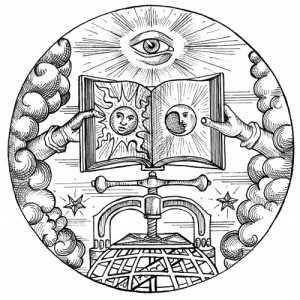
Western Mysticism
Mysticism is not limited to Eastern philosophy. Western mysticism, or the Western Mystery Tradition, originated perhaps as early as the Mycenaean period (1600 – 1100 BCE) with the initiation ceremonies of the ancient Greeks known as the Eleusinian Mysteries.
The root of the words “mysticism” and “mystery” is the Greek μύω, myo or myein, “to close,” especially the eyes and mouth, or “to conceal,” meaning to be kept secret. From this stemmed the Greek mysteria, the secret rite, and mystes, the mystic or initiate of the secret rite.
The gospels and other books of the Christian New Testament describe wisdom and divine revelation as the “Mystery of God” and the “Mystery of Christ.” Mysticism continued with Neoplatonism, a Platonic philosophy that arose out of Hellenistic culture from the third century to the sixth century CE, especially in Alexandria, Egypt. Neoplatonism developed alongside the mystical esoteric tradition of Hermeticism, a philosophy that incorporated alchemy, astrology and theurgy.
The Jewish mystical school known as Kabbalah has likewise had a profound influence on the Western Mystery Tradition. Christianity and Islam also have their embedded mystical traditions. The Jewish and Christian traditions include seated meditations that involve equivalents to Illumination meditation. These will be examined in future articles. Western secular parties, such as scientists and doctors, have likewise utilized similar sitting meditation as a conduit for mystical experience.
Following the example of Jesus of Nazareth, Christianity has its mystics, like Pseudo-Dionysius the Areopagite, Julian of Norwich, Meister Eckhardt, Thomas à Kempis and Ignatius Loyola.
The founders of the Christian monastic orders, Saint Benedict, Dominic de Guzmán, and Francis of Assisi, were mystics. Mystical union with God is the ultimate goal of Christian monasticism, which centers around a schedule of meditation called the Liturgy of the Hours, based on the ancient practice of Lectio Divina, or “Divine Reading.”
Sufism is the Islamic form of mysticism, which began very soon after the death of Mohammed, the founder of Islam. Sufis are often ascetics who congregate around a teacher and Sufi orders normally trace their lineage back to Mohammed. Sufi mysticism is contained in practices such as meditative prayer, ritual or ecstatic dancing.
The end of the quest of symbolic alchemy, from ancient China and Egypt, to the Renaissance, Rosicrucianism and modern Freemasonry, is the mystical union. Western secular mysticism is found in Gnosticism, Unitarianism and Theosophy.
The English Romantic authors like William Blake, William Wordsworth and Percy Shelley and nineteenth century American transcendentalist writers like Henry David Thoreau, Ralph Waldo Emerson and Walt Whitman wove mysticism into their writings.
William James (1842 – 1910) famously proposed a secular theory of mysticism in The Varieties of Religious Experience, known as Perennialism, proposing that a common mystical religious experience manifested itself in the various traditions.
Carl Jung’s analytical psychology aimed for individuation, which Jung described in Psychology and Religion (p. 294), “Individuation is a philosophical, spiritual and mystical experience.” Contemporary transpersonal psychology, psychology of religion and neuroscience of religion are studies of spirituality, including mystical experiences.
Although mystical experiences vary among different systems, the ultimate goal of mystical practices is the same: union with the Illimitable. As descriptions and dogmas are limiting, that which transcends all dualities must be nameless, and there must be myriad perspectives along the mystical path. Science has yet to really examine this peculiar state of mind; the mystical union known as enlightenment. This seems to be a grave oversight.
If those who have experienced enlightenment are right, then all science and education ought to revolve around the wisdom of enlightenment. The most enlightened would have every person structure their life around Illumination.

Science Glances at Enlightenment
One might hope that a subject as lofty as enlightenment would be very well investigated by the world’s best minds, but this is far from true in this world of confused priorities. Although some inquiry exists, the issue of enlightenment as heightened awareness or identification with the cosmos has not been robustly addressed by scientists.[78]
Some researchers have difficulty even defining enlightenment, much less measuring it, while others point to correlations between objective neurophysiological measures and subjective experiences such as non-duality, bodily awareness, clarity and focus.[79]
Humanistic psychology has developed the theory of self-actualization as the realization of one’s full potential, popularized as the apex of Abraham Maslow’s hierarchy of needs pyramid, being the consummation of health.[80] Yet, although it is worthy of attention as a possible higher or ultimate state of consciousness, enlightenment does not appear in any such model. It could be posited, for example, that like the four stages of sleep, the state of wakefulness of an observer may be defined by five stages of waking: alertness, awareness, consciousness, temporary enlightenment and complete enlightenment.
In the 1960s the British philosopher Walter Stace published Mysticism and Philosophy, an analysis of mystical experiences as described in various religious works. He found, like William James, that certain aspects of mysticism were common to all cultures and beliefs. This observation is today known as the common core thesis. Stace’s six core characteristics of mystical experience are: sacredness, noetic quality (meaning and reality), positive mood, ineffability (indescribable), paradoxicality, and transcendent of time and space.
In the 1970s the American professor of psychology Ralph Hood used Stace’s list to develop his eight-point Mysticism Scale: ego quality, unifying quality, inner subjective quality, temporal/spatial quality, noetic quality, ineffability, positive aspect, and religious quality.[81] Certain theologians and philosophers point out that cultural, religious and personal context influences how subjects interpret mystical experiences. However, this fact does not detract from the usefulness of observations of essential common elements of mystical experience. Hood’s work is a continuing influence on the science of mysticism.[82][83][84]
Toward a Science of Enlightenment
A 43-item survey concerning mystical experiences induced by psilocybin mushrooms called The Mystical Experiences Questionnaire was created by scientists in the 1960s to explore the relationship between psychedelics and altered states of mind.[85][86] A modified 30-question version, known as the Revised Mystical Experiences Questionnaire, was developed later and put online, and may apply to experiences during meditation.
Most common among subjects’ experiences was Positive Mood, followed by Ineffability, Transcendence, and Mystical experiences. Other experiences include “feelings of peace and tranquility,” a feeling of an encounter with “ultimate reality,” “timelessness,” insight that “all is One,” “unity with ultimate reality,” and similar experiences.[87]
If the above mystical experiences are compared against regular waking consciousness and then against scientific knowledge, something very interesting may be observed. Biology shows that natural selection, or survival of the fittest, demands an ego-centric point-of-view, which is expressed in competition for resources, social status and viable mating partners. This is realized in basic animal instincts and normal day-to-day consciousness.
Community, cooperation and trade in resources and ideas are also elements of human survival. Morality, religion and government were created to expedite and govern these dynamics. This, too, is realized in normal everyday consciousness, but these higher functions often can only be fulfilled when cosmic, ecological and social interconnectedness and interdependence are understood. This means they are grasped by the intellect, informed by science and illumined by mystical experience.
This fully engaged mind observes a perception that is closer to reality, which certainly has practical uses in critical thinking and decision-making. Such a view hearkens back to the Zen Buddhist assertion that the enlightened mind is the ordinary mind, a mind that is not self-centered, but down-to-earth, open and free.[88]
The “three marks of existence” of Buddhist philosophy, listed in the well-known scripture called the Dhammapada, are duhkha, anicca and anatta. Duhkha is dissatisfaction or suffering, the Buddha’s first of the Four Noble Truths, that all life is accompanied by dissatisfaction in the form of cravings and disliking.
Anicca is the impermanence of all states of being: from the constant motion of the universe, to life and death, to situations and feelings that come and go. Anatta is non-self: all things are interconnected and in a state of transformation, with no permanent or stable selfhood; and all perceived phenomena are empty or illusionary, because no one can perceive the whole universe at once as it really is.
Physics and astronomy, especially cosmology, study the evolution of the universe as a whole, describing with empirical evidence a single, interconnected universe just as is described by the mystical experience of the ultimate reality that all is One.
Science is not, itself, a belief system or a way of life, it is simply a method, the best method available, of discovering objective truth. One may argue that the best way of life incorporates critical thinking, science and a tradition of community, compassion and wisdom such as Buddhism. Certainly a scientific humanist can benefit from the teachings of Buddhism, and any way of life can be improved with some knowledge of modern science.

The Modern Science of Enlightenment
The eminent researchers Daniel Goleman and Richard Davidson collaborated on research at Harvard in the 1970s on the psychology of consciousness and meditation. Goleman published his studies of several meditation systems in The Varieties of Meditative Experience in 1977, and his book Emotional Intelligence (1995, Bantam Books) was an international best-seller.
Davidson largely focused on how neuroplasticity allows people to learn compassion and happiness skills. In 2017 the widely published authors Goleman and Richardson together produced Altered Traits: Science Reveals How Meditation Changes Your Mind, Brain, and Body, describing the demonstrable effects of several kinds of meditation, including equanimity and inner peace, traditionally associated with enlightenment.
In the 1990s Chilean philosopher and cognitive neuroscientist Francisco Varela inspired new research in the field of neurophenomenology, wherein the personal subjective conscious experiences of an observer are examined from an objective view, using scientific method.[89] This research incorporates embodied psychology and enactivism, where experiences are considered in context of the physical environment from which they arise, including ecological, social and physiological forces. Such systems-based scientific approach to experience helped open the way for a cross-fertilization of ideas between Buddhism and cognitive science.
Researchers are taking an empirical approach by examining mystical experiences like Samadhi, meditative absorption or enlightenment, from the perspective of neuroscience. The central aspect of enlightenment, the experience of oneness or non-duality of subject (self) and object (other), has been the subject of scientific investigation. Echoing traditional Buddhist views, researchers hypothesize that such a state of mind contributes to increased awareness and compassion.[90]
In 2006 Vinod D. Deshmukh asserted that neuroscience can help explain the yogic meditation of dhyana/Zen and its outcome, Samadhi. He describes meditation as either total engagement, i.e., mindfulness; or total disengagement, i.e., silence and emptiness. The common outcomes are self-understanding, well-being, happiness and a sense of knowing the meaning of life.[91] Future studies in this area showed that Samadhi was related to higher levels of focus, improved memory and increased feelings of joy.[92] Thus, the findings of science are aligning with traditional Buddhist claims of the effects of meditation.
Andrew Newberg, M.D., an expert in nuclear medicine brain imaging, literally wrote the book on the neuroscience of religion, Principles of Neurotheology (2010). In his research with Eugene d’Aquili, Dr. Newberg began to explore the juxtaposition of empirical data and mystical experience.[93][94] Newberg studies the biological basis of religion without dismissing religious experiences as delusions; finding that the human brain has naturally evolved to understand reality from various perspectives of consciousness, perception and emotion, including the rational and the mystical.
Fabienne Picard suggested in 2013 that the mystical sense of ineffability, a strong feeling of certainty, may be caused by a dysfunction of the anterior insula of the brain, an area connected with regulation of emotional uncertainty.[95] A study in 2019 reinforces the conclusion that the dorsal anterior insula plays a major role in ecstatic experiences.
While mapping the cortex of the brain and triggering seizures for pre-surgical evaluations in three patients with epilepsy, researchers studied ecstatic changes induced by direct intracerebral electrical stimulation (ES) via implanted intracerebral electrodes (stereotactic-EEG, SEEG). It was found that ecstatic auras were reproduced only by stimulation of the dorsal anterior insula.[96]

Conclusion
Philosophically, scientifically reducing mystical experience to brain activity poses an interesting challenge to faith-based religious believers: does this prove that mystical experiences are just psychological phenomena of physical process devoid of any kind of supernatural power or extra-brain consciousness?[97]
The evidence from neuroscience seems to suggest that consciousness and the mind are in fact produced by and contained within the nervous system, and no conscious, intellectual or emotional entity exists outside of the brain.[98]
Consciousness is not some kind of magical spirit, but a biological phenomenon developed by evolution. This does not minimize the import of meditation or mystical experience. Meditation and enlightenment not only offer many psychological benefits, but stand on their own, described by Dogen Zenji as practice-realization, as part of a life of meaning, wisdom and compassion.
We can see that at present the science of meditation is yet in its earliest stages, doing not much more than recording subjective experiences and looking at the most superficial physiological responses, like brainwaves, heart rate, respiration rate and skin conductance.
Ideally in the future, science will not just be able to explain the mechanisms behind enlightenment experiences, but it will also describe the optimum conditions and causes of a hierarchy of such experiences. It will help provide context and perspective on what enlightenment means and how it relates to human affairs and our daily lives.
Future scientists might be able to prescribe meditation with a clear understanding of the anatomy and physiology behind “just sitting,” and the mechanisms behind all the proper behavior to support the practice. Until then, we can look to experienced meditators like Zen Buddhist monks, who suggest that, in the words of Dogen Zenji (Shobogenzo, “Gyobutsu Igi”):
“A step forward is a mistake, a step backward is also a mistake; one step is a mistake, two steps is a mistake, thus (life is/words are) one mistake after another.”
Notes/Bibliography
1. Eihei Dogen, the founder of the Soto Zen sect, calls this eko hensho (withdrawing, turning the light inwards, illuminating the True Self) in the Fukanzazengi, and taisho hensho (taking the backward step of inner illumination) in the Eihei Shingi chapter, “Instructions for the Tensho.” See Taigen Daniel Leighton and Shohaku Okumura, Dogen’s Pure Standards for the Zen Community: A Translation of the Eihei Shingi, State University of New York Press, Albany, 1996, p. 52 (note 14).
2. Ethan Lester, Amy Murrell, Dickson E. Dickson, “A Mixed Methods Approach to Understanding Conceptions of Mindfulness Meditation,” OBM Integrative and Complementary Medicine, 15 Oct., 2018, https://www.researchgate.net/publication/328315150_
A_Mixed_Methods_Approach_to_Understanding_Conceptions_of_Mindfulness_Meditation
3. For a thorough study of the mechanisms behind this process, see “Power of the Mind 3: The Mind-Body Synthesis.” (LINK UNDER CONSTRUCTION)
4. “Consciousness,” Nature.com, Accessed 30 Nov., 2018, https://www.nature.com/subjects/consciousness
5. “Altered States of Consciousness – Science Topic,” ResearchGate, Accessed 30 Nov., 2018, https://www.researchgate.net/topic/Altered-States-Of-Consciousness
6. University of Sussex, “First evidence for higher state of consciousness found,” Medical Xpress, 19 April, 2017, https://medicalxpress.com/news/2017-04-evidence-higher-state-consciousness.html
7. George A. Mashour, “The controversial correlates of consciousness,” Science 04 May, 2018: Vol. 360, Issue 6388, pp. 493-494, http://science.sciencemag.org/content/360/6388/493
8. Fiona Macdonald, “Harvard Scientists Think They’ve Pinpointed The Physical Source of Consciousness,” Science Alert, 23 June, 2018, https://www.sciencealert.com/harvard-scientists-think-they-ve-pinpointed-the-neural-source-of-consciousness
9. Christof Koch, “What Is Consciousness?” Scientific American, 1 June, 2018, https://www.scientificamerican.com/article/what-is-consciousness/
10. PT Staff, “Anatomy of Attention,” Psychology Today, June 9, 2016, https://www.psychologytoday.com/us/articles/199207/anatomy-attention
11. Anne Trafton, “How the Brain Pays Attention,” MIT News, April 2014, http://news.mit.edu/2014/how-brain-pays-attention
12. The Cambridge Declaration on Consciousness, 7 July, 2012, http://fcmconference.org/img/CambridgeDeclarationOnConsciousness.pdf
13. Andrew B. Barron and Colin Klein, “What insects can tell us about the origins of consciousness,” 18 April, 2016, http://www.pnas.org/content/early/2016/04/13/1520084113?sid=b6e609eb-fc92-478a-91fc-5980f1f59e41
14. William James, Psychology: Briefer Course, Macmillan, London, 1892.
15. “In alchemy there lies concealed a Western system of yoga meditation, but it was kept a carefully guarded secret from fear of heresy and its painful consequences.” Carl Jung, CW 16, Para 219. https://carljungdepthpsychologysite.blog/2018/05/19/carl-jung-on-meditation-anthology/#.W435ypMzbMI
16. “If you take the concept of prayer in its widest sense and if you include also Buddhist contemplation And Hindu meditation (as being equivalent to prayer), one can say that it is the most universal form of religious or philosophical concentration of the mind and thus not only one of the most original but also the most frequent means to change the condition of mind.” Carl Jung, Letters Vol. I, Page 558. https://carljungdepthpsychologysite.blog/2018/05/19/carl-jung-on-meditation-anthology/#.W435ypMzbMI
17. “But we spend our free time listening to the wireless and rushing off to the cinema. Yet much of our western neurosis comes from the fact that we do not find enough time for ourselves; it would be wiser to meditate and seek the Void when we need rest, than to run after outer distraction.” Carl Jung, ETH Lectures, Page 128. https://carljungdepthpsychologysite.blog/2018/05/19/carl-jung-on-meditation-anthology/#.W435ypMzbMI
18. The Secret of the Golden Flower (T’ai I Chin Hua Tsung Chih), Translated by Richard Wilhelm; Translated from German by Cary F. Baynes; Published by Kegan Paul, Trench and Trubner (1931); Routledge and Kegan Paul Ltd (1965), http://www.spiritandflesh.com/Chinese_SecretoftheGoldenFlower_online.htm
19. Joseph Loizzo, “Meditation research, past, present, and future: perspectives from the Nalanda contemplative science tradition,” Annals of the New York Academy of Sciences, 1307(1), Jan., 2014, pp. 43–54, https://www.ncbi.nlm.nih.gov/pmc/articles/PMC4253124/
20. Deane H. Shapiro (Jr.), Roger N. Walsh, Meditation: Classic and Contemporary Perspectives, Aldine Publishing Company, Hawthorne, New York, 1984, p. 5.
21. Frank G. Echenhofer and Mary M. Coombs, “A Brief Review of Research and Controversies in EEG Biofeedback and Meditation,” The Journal of Transpersonal Psychology, 1987, Vol. 19. No.2.
22. “Mindfulness or Mindfulness-Based Cognitive Therapy?” Centre of Excellence, 6 June, 2018, https://www.centreofexcellence.com/what-is-the-difference-between-mindfulness-and-mindfulness-based-cognitive-therapy-2/
23. R. Marchand, “Mindfulness-based stress reduction, mindfulness-based cognitive therapy, and Zen meditation for depression, anxiety, pain, and psychological distress,” Journal of Psychiatric Practice, 18(4), 18 July, 2012, pp. 233-52, https://www.ncbi.nlm.nih.gov/pubmed/22805898
24. Christine E. Parsons, PhD, Catherine Crane, PhD, Liam J. Parsons, MA, Lone Overby Fjorback, PhD, and Willem Kuyken, PhD, “Home practice in Mindfulness-Based Cognitive Therapy and Mindfulness-Based Stress Reduction: A systematic review and meta-analysis of participants’ mindfulness practice and its association with outcomes,” Behaviour Research and Therapy, 95, Aug., 2017, pp. 29–41, https://www.ncbi.nlm.nih.gov/pmc/articles/PMC5501725/
25. Philippe R. Goldin and James J. Gross, “Effects of Mindfulness-Based Stress Reduction (MBSR) on Emotion Regulation in Social Anxiety Disorder,” Emotion, Feb; 10(1), 2010, pp. 83–91, https://www.ncbi.nlm.nih.gov/pmc/articles/PMC4203918/
26. Shian-Ling Keng, Moria J. Smoski, and Clive J. Robinsa, “Effects of Mindfulness on Psychological Health: A Review of Empirical Studies,” Clinical Psychological Review, 31(6), Aug., 2011, pp. 1041–1056, https://www.ncbi.nlm.nih.gov/pmc/articles/PMC3679190/
27. Aishwarya Raj & Pradeep Kumar, “Efficacy of Mindfulness Based Stress Reduction (MBSR): A Brief Overview,” Journal of Disability Management and Rehabilitation, 4(1), 2018, pp. 73-81, https://www.researchgate.net/publication/328540330_Efficacy_of_Mindfulness_Based_Stress_Reduction_MBSR_A_Brief_Overiew
28. Kelsey Evans, Nirmal Ghimire, Shiva Jahani, Suat Babayigit, “The effectiveness of mindfulness meditation based stress reduction using outcome questionnaire 45.2 among college students,” Conference Paper: Florida Educational Research Association (FERA), Nov. 2018, https://www.researchgate.net/publication/328051490_The_effectiveness_of_mindfulness_meditation_based
_stress_reduction_using_outcome_questionnaire_452_among_college_students
29. Helane Wahbeh, “Internet Mindfulness Meditation Intervention (IMMI) Improves Depression Symptoms in Older Adults,” Medicines 2018, 5(4), p. 119; https://doi.org/10.3390/medicines5040119
30. Eileen Luders, Kristi Clark, Katherine L.Narr, Arthur W.Toga, “Enhanced brain connectivity in long-term meditation practitioners,” NeuroImage, Volume 57, Issue 4, 15 Aug. 2011, pp. 1308-1316, https://www.sciencedirect.com/science/article/abs/pii/S1053811911006008
31. Teasdale J.D., Segal Z.V., Williams J.M., Ridgeway V.A., Soulsby J.M., Lau M.A., “Prevention of Relapse/Recurrence in Major Depression by Mindfulness-Based Cognitive Therapy,” Journal of Consulting and Clinical Psychology 68(4), pp. 615-23, Sept. 2000, https://www.ncbi.nlm.nih.gov/pubmed/10965637
32. Hayes, S. C.; Masuda, Akihiko; Bissett, R.; Luoma, J.; and Guerrero, L. F., “DBT, FAP, and ACT: How empirically oriented are the new behavior therapy technologies?” Psychology Faculty Publications, 82, 2004, https://scholarworks.gsu.edu/psych_facpub/82
33. Hayes, S. C., Follette, V. M., & Linehan, M. M. (Eds.), “Mindfulness and acceptance: Expanding the cognitive-behavioral tradition,” New York, NY, US: Guilford Press, 2004, https://psycnet.apa.org/record/2005-02461-000
34. Christopher K. Germer, Ronald D. Siegel, Paul R Fulton (Editors), Mindfulness and Psychotherapy, The Guilford Press, New York, London, 2005, pp. 19-22.
35. Ospina MB, Bond TK, Karkhaneh M, Tjosvold L, Vandermeer B, Liang Y, Bialy L, Hooton N, Buscemi N, Dryden DM, Klassen TP. “Meditation Practices for Health: State of the Research. Evidence Report/Technology Assessment No. 155.” (Prepared by the University of Alberta Evidence-based Practice Center under Contract No. 290-02-0023.) AHRQ Publication No. 07-E010. Rockville, MD: Agency for Healthcare Research and Quality. June 2007. Archived from the original (PDF) on 25 February 2009, https://web.archive.org/web/20090225175425/http://www.ahrq.gov/downloads/pub/evidence/pdf/meditation/medit.pdf
36. Madhav Goyal, MD, MPH1; Sonal Singh, MD, MPH1; Erica M. S. Sibinga, MD, MHS2; et al, “Meditation Programs for Psychological Stress and Well-being: A Systematic Review and Meta-analysis,” JAMA Intern Med., March 2014, 174(3) pp. 357-368, https://jamanetwork.com/journals/jamainternalmedicine/fullarticle/1809754
37. Madhav Goyal, MD, MPH, Sonal Singh, MD, MPH, Erica Sibinga, MD, MHS, et al, Rockville (MD): Agency for Healthcare Research and Quality (US), “Meditation Programs for Psychological Stress and Well-Being,” Comparative Effectiveness Reviews, No. 124, Jan., 2014, https://www.ncbi.nlm.nih.gov/books/NBK180102/
38. Stetka B (October 2017). “Where’s the Proof That Mindfulness Meditation Works?”. Scientific American. https://www.scientificamerican.com/article/wheres-the-proof-that-mindfulness-meditation-works1/
39. Nicholas T Van Dam, Marieke K Van Vugt, David R Vago, et al, (2017). “Reiterated Concerns and Further Challenges for Mindfulness and Meditation Research: A Reply to Davidson and Dahl”. Perspectives on Psychological Science. 13 (1): 66–69. https://www.ncbi.nlm.nih.gov/pmc/articles/PMC5817993/
40. Nicholas T Van Dam, Marieke K Van Vugt, David R Vago, et al, (January 2018). “Mind the Hype: A Critical Evaluation and Prescriptive Agenda for Research on Mindfulness and Meditation”. Perspectives on Psychological Science. 13 (1): 36–61. https://www.ncbi.nlm.nih.gov/pmc/articles/PMC5758421/
41. Travis and J. Shear, “Focused attention, open monitoring and automatic self-transcending: Categories to organize meditations from Vedic, Buddhist and Chinese traditions,” Consciousness and Cognition 19(4), Dec., 2010, https://www.ncbi.nlm.nih.gov/pubmed/20167507/
42. Antoine Lutz, Lawrence L. Greischar, Nancy B. Rawlings, Matthieu Ricard, and Richard J. Davidson, “Long-term meditators self-induce high-amplitude gamma synchrony during mental practice,” PNAS, 16 Nov., 2004, 101 (46), pp. 16369-16373, https://www.pnas.org/content/101/46/16369.full
43. Aishwarya Raj and Pradeep Kumar, “Efficacy of Mindfulness Based Stress Reduction (MBSR): A Brief Overview,” Journal of Disability Management and Rehabilitation, 4(1), 26 Oct., 2018, https://www.researchgate.net/publication/328540330_Efficacy_of_Mindfulness_Based_Stress_Reduction_MBSR_A_Brief_Overiew
44. Emma Seppälä Ph.D., “20 Scientific Reasons to Start Meditating Today,” Psychology Today, 11 Sept., 2013, https://www.psychologytoday.com/us/blog/feeling-it/201309/20-scientific-reasons-start-meditating-today
45. Jindal, S. Gupta, R. Das, “Molecular mechanisms of meditation,” Mol Neurobiol., Dec., 2013, 48(3), pp. 808-11, https://www.ncbi.nlm.nih.gov/pubmed/23737355
46. B. Newberg, J. Iversen, “The neural basis of the complex mental task of meditation: neurotransmitter and neurochemical considerations,” Med Hypotheses. Aug., 2003, 61(2), pp. 282-91, https://www.ncbi.nlm.nih.gov/pubmed/12888320
47. Krisanaprakornkit, W. Krisanaprakornkit, N. Piyavhatkul, M. Laopaiboon, Meditation therapy for anxiety disorders, Cochrane Database Syst Rev., 25 Jan., 2006, (1):CD004998, https://www.ncbi.nlm.nih.gov/pubmed/16437509
48. Rebecca Gladding M.D., “This Is Your Brain on Meditation,” Psychology Today, 22 May, 2013, https://www.psychologytoday.com/us/blog/use-your-mind-change-your-brain/201305/is-your-brain-meditation
49. Kate F. Hays Ph.D., “The Transient Hypofrontality Edge,” Psychology Today, 13 March, 2017, https://www.psychologytoday.com/intl/blog/the-edge-peak-performance-psychology/201703/the-transient-hypofrontality-edge
50. Mohandas, M.D., “Neurobiology of Spirituality,” Mens Sana Monographs, 6(1), Jan-Dec., 2008, pp. 63–80, https://www.ncbi.nlm.nih.gov/pmc/articles/PMC3190564/
51. Mark Wheeler, “Is meditation the push-up for the brain?” Medical Xpress, 14 July, 2011, https://medicalxpress.com/news/2011-07-meditation-push-up-brain.html
52. Richard J. Davidson and Antoine Lutz,“Buddha’s Brain: Neuroplasticity and Meditation,” IEEE Signal Process Magazine, 25(1), 01 Jan., 2008, pp. 174 – 176, https://www.ncbi.nlm.nih.gov/pmc/articles/PMC2944261/
53. Brefczynski-Lewis JA1, Lutz A, Schaefer HS, Levinson DB, Davidson RJ, “Neural correlates of attentional expertise in long-term meditation practitioners,” Proceedings of National Academy of Sciences of the U.S.A., 3 July, 2007, https://www.ncbi.nlm.nih.gov/pubmed/17596341/
54. Yusainy and C. Lawrence, “Brief mindfulness induction could reduce aggression after depletion,” Conscious Cogn., May 2015, 33, pp. 125-34, https://www.ncbi.nlm.nih.gov/pubmed/25562288
55. Diane Land, “Study shows compassion meditation changes the brain,” University of Wisconsin–Madison News, 25 March, 2008, https://news.wisc.edu/study-shows-compassion-meditation-changes-the-brain/
56. Antoine Lutz, Julie Brefczynski-Lewis, Tom Johnstone, Richard J. Davidson, “Regulation of the Neural Circuitry of Emotion by Compassion Meditation: Effects of Meditative Expertise,” Plos One 3(3): e189726, March, 2008, https://journals.plos.org/plosone/article?id=10.1371/journal.pone.0001897
57. Michael R. Hagerty, Julian Isaacs, Leigh Brasington, Larry Shupe, Eberhard E. Fetz, and Steven C. Cramer, “Case Study of Ecstatic Meditation: fMRI and EEG Evidence of Self-Stimulating a Reward System,” Neural Plasticity Volume 2013, Article ID 653572, 12 pages, http://dx.doi.org/10.1155/2013/653572
58. “The New Science of Happiness”. Time Magazine, Claudia Wallis, January 9, 2005. Archived from the original on August 19, 2010. Retrieved 14 Nov. 2019, https://web.archive.org/web/20100819065528/http://www.time.com/time/magazine/article/0,9171,1015902,00.html
59. Ed Diener and Micaela Y. Chan, “Happy people live longer: Subjective well-being contributes to health and longevity,” Applied Psychology: Health and Well-Being 3 (1), pp. 1–43, 2011, https://onlinelibrary.wiley.com/doi/abs/10.1111/j.1758-0854.2010.01045.x
60. DeNeve, J-E., Diener, E., Tay, L., & Xuereb, C., “The objective benefits of subjective well-being.” In J. F. Helliwell, R. Layard, & J. Sachs (Eds.), World Happiness Report 2013. Volume 2. (pp. 54–79), New York, UN Sustainable Network Development Solutions Network.
61. Emma Luxton, “What one of the world’s longest studies tells us about happiness,” World Economic Forum, 05 Jan., 2016, https://www.weforum.org/agenda/2016/01/what-one-of-the-worlds-longest-studies-tells-us-about-happiness?utm_content=buffer9209e&utm_medium=social&utm_source=facebook.com&utm_campaign=buffer
62. Ethan Wolff-Mann, “What the New Nobel Prize Winner Has to Say About Money and Happiness,” Money, 13 Oct., 2015, http://time.com/money/4070041/angus-deaton-nobel-winner-money-happiness/
63. Daniel Kahneman and Angus Deaton, “High income improves evaluation of life but not emotional well-being,” PNAS, 4 Aug., 2010, https://www.princeton.edu/~deaton/downloads/deaton_kahneman_high_income_improves_evaluation_August2010.pdf
64. Ron Breazeale Ph.D., “The Role of the Brain in Happiness,” Psychology Today, 19 Feb., 2013, https://www.psychologytoday.com/intl/blog/in-the-face-adversity/201302/the-role-the-brain-in-happiness
65. Alex Lickerman M.D., “How to Reset Your Happiness Set Point,” Psychology Today, 21 April, 2013, https://www.psychologytoday.com/us/blog/happiness-in-world/201304/how-reset-your-happiness-set-point
66. Zak Stambor, “Is our happiness set in stone?” American Psychological Association, December 2007, Vol 38, No. 11, https://www.apa.org/monitor/dec07/happiness.aspx
67. Princeton Survey Research Associates International, “Are We Happy Yet?” Pew Research Center, 13 Feb., 2006, https://www.pewsocialtrends.org/2006/02/13/are-we-happy-yet/
68. Jerry Coyne, “The 2018 UN World Happiness Report: most atheistic (and socially well off) countries are the happiest, while religious countries are poor and unhappy,” Why Evolution is True, 20 March, 2018, https://whyevolutionistrue.wordpress.com/2018/03/20/the-2018-un-world-happiness-report-most-atheistic-and-socially-well-off-countries-are-the-happiest-while-religious-countries-are-poor-and-unhappy/
69. Helliwell, J., Layard, R., & Sachs, J., World Happiness Report 2019, New York: Sustainable Development Solutions Network, https://worldhappiness.report/ed/2019/
70. Robert Puff Ph.D., “Meditation Can Make You Smarter (and Happier),” Psychology Today, 13 Sept., 2013, https://www.psychologytoday.com/us/blog/meditation-modern-life/201309/meditation-will-make-you-smarter-and-happier
71. Stephanie Pappas, “Why Religion Makes Only Some of Us Happy,” Live Science, 25 Jan., 2012, https://www.livescience.com/18117-religion-happiness-countries.html
72. Scott Barry Kaufman, “What Would Happen If Everyone Truly Believed Everything Is One?” Scientific American, 8 Oct., 2018, https://blogs.scientificamerican.com/beautiful-minds/what-would-happen-if-everyone-truly-believed-everything-is-one/
73. Christopher K. Germer, Ronald D. Siegel, Paul R Fulton (Editors), Mindfulness and Psychotherapy, The Guilford Press, New York, London, 2005, pp. 25-26.
74. Barbara O’Brien, “Samurai Zen: The Role of Zen in japan’s Samurai Culture,” Learn Religions, 13 Jan., 2018, https://www.thoughtco.com/role-of-zen-in-samurai-culture-449944
75. See Lawrence M. Krauss, A Universe from Nothing: Why There Is Something Rather than Nothing (2013) and Frank Close, Nothing, A Very Short Introduction (2009) and The Void (2013).
76. See Fritjof Capra, The Tao of Physics: An Exploration of the Parallels Between Modern Physics and Eastern Mysticism (2010)
77. Stephen Kaplan, “Scientific Approaches to Mysticism,” Oxford Research Encyclopedias, June 2016, https://oxfordre.com/religion/view/10.1093/acrefore/9780199340378.001.0001/acrefore-9780199340378-e-3
78. Sam Harris, “Waking Up with Sam Harris #102 – Is Buddhism True? (with Robert Wright),” YouTube video, 2:13:22, 30 Oct., 2007, https://www.youtube.com/watch?v=i9SGs89x8lY
79. Jake H. Davis and David R. Vago, “Can enlightenment be traced to specific neural correlates, cognition, or behavior? No, and (a qualified) Yes,” Frontiers in Psychology, 4, 2013, p. 870, https://www.ncbi.nlm.nih.gov/pmc/articles/PMC3837242/
80. Ann Olson Psy.D., “The Theory of Self-Actualization: Mental illness, creativity, and art,” Psychology Today, 13, Aug., 2013, https://www.psychologytoday.com/gb/blog/theory-and-psychopathology/201308/the-theory-self-actualization
81. Ralph W. Hood, Jr., “The Construction and Preliminary Validation of a Measure of Reported Mystical Experience,” Journal for the Scientific Study of Religion, 14(1), March, 1975, pp. 29-41, https://www.jstor.org/stable/pdf/1384454.pdf?seq=1
82. Dale Caird, “The Structure of Hood’s Mysticism Scale: A Factor-Analytic Study.” Journal for the Scientific Study of Religion, 27(1), March, 1988, pp. 122-127, https://www.jstor.org/stable/1387407?seq=1
83. Ralph W. Hood, Jr., Ronald J. Morris & Paul J. Watson, “Further factor analysis of Hood’s Mysticism Scale,” Psychological Reports, Dec. 1993, 73(3), pp. 1176-1183.
84. Duane F. Reinert, & Kenneth R. Stifler, “Hood’s Mysticism Scale Revisited: A Factor-Analytic Replication,” Journal for the Scientific Study of Religion, 32(4), Dec. 1993, p. 383, https://www.researchgate.net/publication/272929196_Hood’s_Mysticism_Scale_Revisited_A_Factor-Analytic_Replication
85. Katherine A. MacLean, Jeannie‐Marie S. Leoutsakos, Matthew W. Johnson, Roland R. Griffiths, “Factor Analysis of the Mystical Experience Questionnaire: A Study of Experiences Occasioned by the Hallucinogen Psilocybin,”Journal for the Scientific Study of Religion, 51(4), 4 Dec., 2012, pp. 721-737, https://onlinelibrary.wiley.com/doi/full/10.1111/j.1468-5906.2012.01685.x
86. Frederick S Barrett, Matthew W Johnson, Roland R Griffiths, “Validation of the revised Mystical Experience Questionnaire in experimental sessions with psilocybin,” Journal of Psychopharmacology, 29(11), 6 Oct., 2015, pp. 1182-1190, https://journals.sagepub.com/doi/abs/10.1177/0269881115609019?journalCode=jopa
87. Vieten, H. Wahbeh, B. R. Cahn, K. MacLean, M. Estrada, P. Mills, et al. (2018).
88. “Joshu asked Nansen, ‘What is the Way?’ Nansen replied, ‘Ordinary mind is the Way.’” Wumen Huikai (1183–1260), Mumonkan (“The Gateless Gate”), Ch. 19.
89. Francisco Varela, Evan Thompson and Eleanor Rosch, The Embodied Mind: Cognitive Science and Human Experience, MIT Press, 1991, Rev. 2017.
90. Vieten, H. Wahbeh, B. R. Cahn, K. MacLean, M. Estrada, P. Mills, et al., “Future directions in meditation research: Recommendations for expanding the field of contemplative science,” PLoS ONE 13(11), 7 Nov., 2018, https://www.researchgate.net/publication/328796591_Future_directions_in_meditation_research_
Recommendations_for_expanding_the_field_of_contemplative_science#pf1a
91. Vinod D. Deshmukh, “Neuroscience of Meditation,” The Scientific World JOURNAL, 16 Nov., 2006, pp. 2239–2253, https://www.ncbi.nlm.nih.gov/pmc/articles/PMC5917255/pdf/TSWJ-2006-6-740623.pdf
92. Jeremy Yamashiro, “Brain Basis of Samadhi: The Neuroscience of Meditative Absorption,” The New School Psychology Bulletin, Vol. 13, No. 1, 2015, http://www.nspb.net/index.php/nspb/article/view/260
93. Newberg, Andrew & d’Aquili, Eugene, Why God Won’t Go Away: Brain Science and the Biology of Belief, Random House LLC, 2008.
94. Newberg, Andrew & Waldman, Mark Robert (2009), How God Changes Your Brain, New York: Ballantine Books.
95. Picard, Fabienne, “State of belief, subjective certainty and bliss as a product of cortical dysfunction,” Cortex, 49 (9), 2013, pp. 2494–2500.
96. Bartolomei, et al., “The Role of the Dorsal Anterior Insula in Ecstatic Sensation Revealed by Direct Electrical Brain Stimulation,” Brain Stimulation, 12(5), 1 Sept., 2019, pp. 1121-1126, https://www.brainstimjrnl.com/article/S1935-861X(19)30230-X/fulltext
97. Jones, Richard H. (2016), Philosophy of Mysticism, Albany, N.Y.: State University of New York Press.
98. Young, J.Z. (1987) Philosophy and the Brain. Oxford University Press, Oxford. pp. 11.


